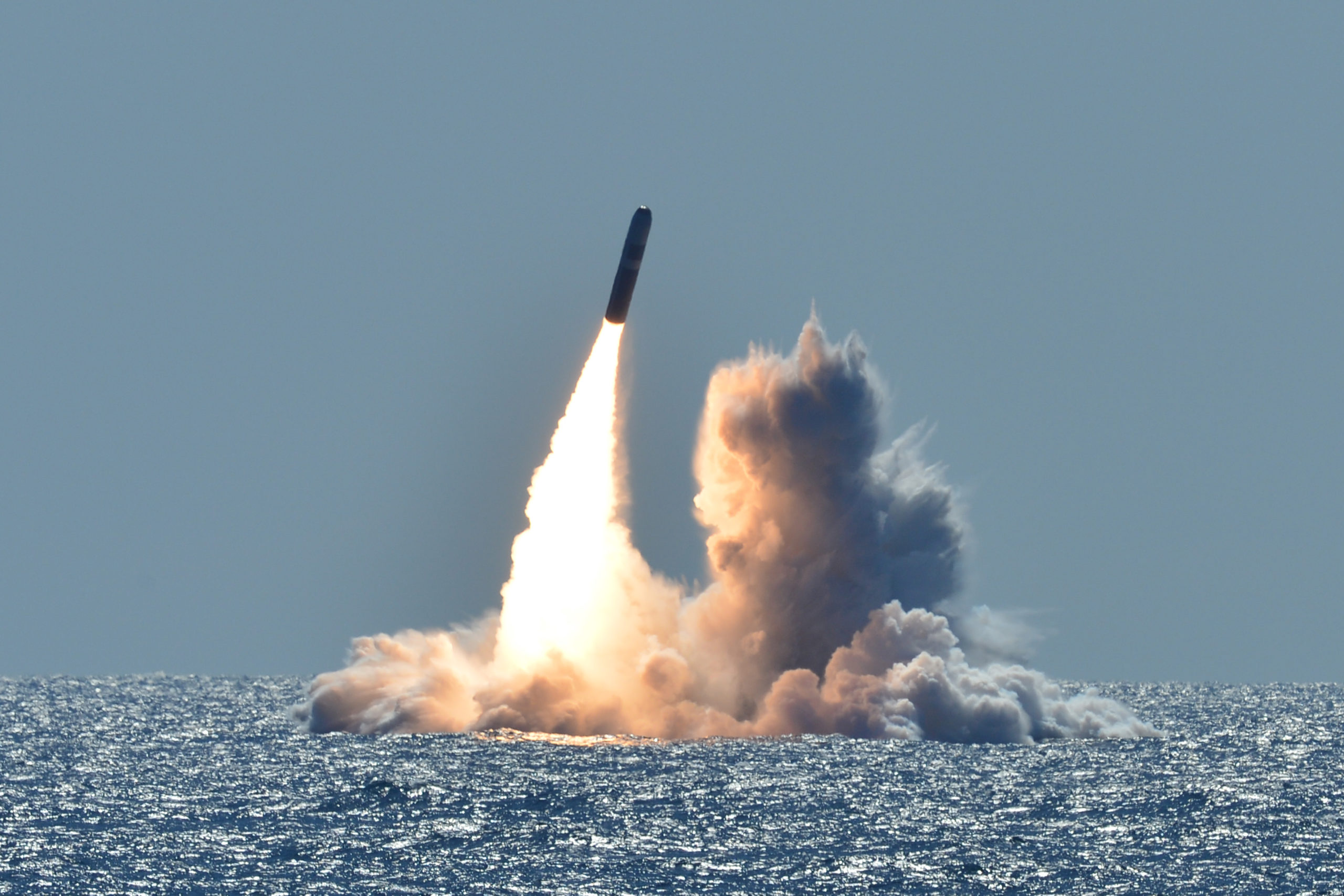Donald Trump is hell-bent to have the United States produce and deploy new and more lethal nuclear weapons—and to pave the way, he has opted to withdraw from a carefully constructed web of international arms control agreements that, although not totally perfect, have effectively deterred the use and slowed the spread of the doomsday arsenal.
Last month, he declared the United States would be withdrawing from the Open Skies Treaty of 1992, a key feature of the verification protocols which allows signatories to conduct observation flights to monitor compliance. “This is insane,” commented the former CIA Director Michael Hayden, an appointee of George W. Bush.
Last year, Trump took the United States out of the Intermediate-Range Nuclear Forces Treaty of 1987, under which the United States and the Soviet Union, and now Russia, eliminated all their nuclear and conventional ballistic and cruise missiles with ranges between 310 and 3,420 miles.
Critics at the time expressed concerns that the U.S. decision would open the door to a new arms race. Mikhail Gorbachev, who with President Ronald Reagan had signed the landmark pact, was unambiguous in response: “This move undermines security . . . in the whole world.”
Now Trump is talking about the resumption of testing of nuclear weapons.
“Testing of nuclear weapons evokes nuclear apocalypse,” says John Burroughs, executive director of the Lawyers Committee on Nuclear Policy. “Nothing short of appalling,” was the reaction of John Tierney, the executive director of the Center for Arms Control and Non-Proliferation, and a former U.S. representative from Massachusetts.
Another former U.S. lawmaker, ex-Senator Bob Corker, cautioned in 2017 about Trump and war. The headline in Time magazine declared: “A Top Republican Says President Trump Could Lead the U.S. Into World War III.” Corker in the article asserted: “I know for a fact that every single day at the White House, it’s a situation of trying to contain him.”
The warning signs were evident early on. According to MSNBC’s Joe Scarborough, as a candidate for U.S. president, Trump reportedly asked a “foreign policy expert” advising him in 2016 about why, “if we had” nuclear weapons, “we can’t use them.”
In 2017, as president, Trump spoke openly at a meeting with advisers, among them the Joint Chiefs of Staff and then–Secretary of State Rex Tillerson, about wanting “a bigger stockpile” of U.S. nuclear weapons, as reported by NBC News. It was after this July 20 meeting that Tillerson famously called Trump a “moron,” noted The Washington Post.
The U.S. buildup of nuclear weaponry under Trump has been substantial.
This past March, the Defense Department announced that on some U.S. ballistic missile submarines, it had deployed a new W76-2 nuclear warhead, described as “low-yield”—eight kilotons in blast power, about half the strength of the atomic bomb dropped on Hiroshima.
“In fact, there are currently over 1,000 nuclear warheads in the U.S. arsenal that have low-yield options,” comments Hans Kristensen, director of the Nuclear Information Program of the Federation of American Scientists. While he noted “serious challenges in Russia and North Korea,” he concluded, “Those challenges can be addressed with the considerable capabilities in the current nuclear arsenal.”
As for the W76-2, “[At] first glance, this might seem like a good thing: a smaller blast means less death and damage, if a nuclear war happened. But in some ways, it’s a dangerous thing,” Fred Kaplan recently wrote on Slate. “For many years, arms control advocates have argued that low-yield [nuclear] weapons are destabilizing because they lower the threshold between conventional and nuclear war. They seem to be—they are designed to be—more usable as weapons of war.”
In 2003, after the invasion of Iraq, Kaplan recalls that some Air Force generals proposed building a low-yield nuclear warhead, but “many members of the House and Senate Armed Services Committee did not trust President George W. Bush with such a weapon, so they tacked on an amendment to that year’s defense budget, prohibiting the ‘testing, acquisition, or deployment of a low-yield nuclear weapon’. . . . Many now have the same worry about Donald Trump.”
The W76-2 issue comes against the backdrop of the deployment of another nuclear missile widely used on U.S. submarines. As the headline in an article published in 2017 in Forbes declared: “Navy’s D5 Missile, Most Powerful U.S. Weapon, to Provide Backbone of Nuclear Deterrent Through 2040.” For credentials, the author, Loren Thompson, discloses that the contractor for the missile, Lockheed Martin, “has been a contributor to my think tank,” the Lexington Institute, of which Thompson is chief operating officer.
Thompson wrote:
As for its potency, a single D5 equipped with multiple independently targetable reentry vehicles carrying nuclear warheads can destroy a small country such as North Korea. A handful of D5s could collapse the entire electrical grid, transportation network and information infrastructure of even the largest countries. And the Navy has hundreds of D5 missiles.
Submarines are on station under the Atlantic or Pacific oceans, they are essentially impossible to find, and thus highly survivable.
That’s why the Pentagon plans to deploy over two-thirds of the warheads in the U.S. strategic arsenal on submarines in the years ahead. A single Ohio-class ballistic missile submarine has two dozen missile tubes, and each of the D5s in those tubes carries at least several nuclear warheads that can be directed at separate targets. The missiles can carry up to 14 warheads. . . . Each warhead has a yield of 100 or 475 kilotons and can hit within 300 feet of intended targets. At those yields—5 to 25 times the explosive power that leveled Hiroshima in 1945—the warheads can destroy pretty much anything. . . . Two minutes after the first stage ignites, the missile is already moving at a speed of 13,000 feet per second, and quickly exits the atmosphere before deploying its reentry vehicles to hit widely separated targets half a world away. The nominal range of the missile is 4,000 nautical miles.
This scenario would be apocalypse from sea.
Now, under Trump, there’s a new scheme for apocalypse from the sky.
The United States is seeking to acquire “volumes of hundreds or even thousands” of nuclear-capable hypersonic missiles that are “stealthy” and can fly undetected at 3,600 miles per hour, according to an article published in Aviation Week & Space Technology last month. Why so many? The piece quotes Mark Lewis, a director at the Pentagon’s Research and Engineering division, as saying: “At the end of the day, we have to be careful we’re not building boutique weapons. If we build boutique weapons, we won’t—we’ll be very reluctant to—use them. And that again factors into our plans for delivering hypersonics at scale.”
The article establishes that, “Air Force and defense officials have been promoting concepts for operating air-launched hypersonic missiles in swarm attacks. The B-1B [bomber], for example, will be modified to carry” six hypersonic missiles.
Headlined: “Hypersonic Mass Production,” the Aviation Week piece has the subhead, “Pentagon Forms Hypersonic Industry ‘War Room.’” The article says: “As the U.S. hypersonic weapons strategy tilts toward valuing a quantity approach, the new focus for top defense planners . . . is to create an industrial base.” So, says Lewis, the Pentagon has created a “war room” to coordinate the development of this “base.”
The United States conducted its first hypersonic missile test in March from its Pacific Missile Range Facility on Kauai, Hawaii. “Fast and Furiously Accurate” was the title of an article about hypersonic missiles written by U.S. Navy Lieutenant Andrea Howard that appeared last year on the U.S. Naval Institute website. The piece declared that by “specifically integrating hypersonic weapons with U.S. Navy submarines, the United States may gain an edge in developing the fastest, most precise weapons the world has ever seen.”
Howard, a former Marshall Scholar at Oxford, where she focused on the intersection of technology, security, and diplomacy in weapons of mass destruction policy, explained that hypersonic weapons “travel faster than Mach 5—at least . . . 3,600 mph, or one mile per second. . . . They are similar to but faster than existing missiles, such as the subsonic U.S. Tomahawk missile, which maxes out around 550 mph.” The piece revealed that the “low-altitude path” of the hypersonic missiles, “when coupled with the curvature of the Earth,” makes them “mostly invisible to early warning radars,” and “they can maneuver during flight; in contrast with the predictable ballistic-missile descent, they are more difficult to intercept, if even detected.”
“By offering the precision of near-zero-miss weapons, the speed of ballistic missiles, and the maneuverability of cruise missiles, hypersonic weapons are a disruptive technology capable of striking anywhere on the globe in less than an hour,” the Navy officer enthused.
The article notes that Russian “President Vladimir Putin unveiled six new” what he called “invincible” hypersonic missiles as part of a March 2018 “state of the nation” speech. “Russia has successfully tested the air-to-ground hypersonic missile,” named Kinzhal (Dagger), “multiple times using the MIG-31 fighter.” Russia is “mounting the Kinzhal on its Tu-22M3 strategic bomber.” The piece adds that “China, too, is working on hypersonic technologies.”
Howard concludes: “As the tradition of arms control weakens with the breakdown of the Intermediate-Range Nuclear Forces agreement, it would be naïve to anticipate anything other than full-fledged weapon development by Russia and China in the coming decades. . . . The bottom line is that hypersonic weapons will determine who precisely is ‘prompt’ enough in 21st century conflict.”
“Hypersonic missiles may be unstoppable. Is society ready?” was the headline of a March article that appeared in The Christian Science Monitor. This piece asserts: “Hypersonic missiles are not just very fast, they are maneuverable and stealthy. This combination of speed and furtiveness means they can surprise an adversary in ways that conventional missiles cannot, while also evading radar detection. And they have injected an additional level of risk and ambiguity into what was already an accelerating arms race between nuclear-armed rivals.”
The article raises the issue of the speed of hypersonic missiles miring military decisions. “For an incoming conventional missile, military commanders may have 30 minutes to detect and respond; a hypersonic missile could arrive at that same destination in 10 minutes.” Thus “artificial intelligence” would be incorporated.
The Christian Science Monitor article quotes Patrick Lin, a professor of philosophy at California Polytechnic State University in San Luis Obispo, as noting: “Technology will always fail. That is the nature of technology.” And, says the article: “Dr. Lin argues that the benefits of hypersonic weapons compared to the risk they create are ‘widely unclear,’ as well as the benefits of the AI systems that inform them.”
It quotes Dr. Lin as saying, wisely: “I think it’s important to remember that diplomacy works and policy solutions work. . . . I think another tool in our toolbox isn’t just to invest in more weapons, but it’s also to invest in diplomacy to develop community.”
Meanwhile, the United States is investing in a “modernization” of its nuclear weapons arsenal—a program that began under President Barack Obama, and which Trump has enthusiastically continued.
A new nuclear production program intended to expand the production of plutonium-based explosive triggers for use in hydrogen bombs is planned for the Department of Energy’s Savannah River Site in South Carolina. As a “Nuclear Posture Review” issued by the secretary of the U.S. Department of Defense in 2018 stated, “We must recapitalize our Cold War legacy nuclear forces.”
The arms control regime that Navy Lieutenant Howard perceives as weakening has often stumbled over alleged violations on all sides, but the constraints in place against deployment and more recent restrictions against testing have overall been effective.
The Treaty on the Non-Proliferation of Nuclear Weapons, an international agreement that took force in 1970—and which the United States has signed and Trump has not yet sought to withdraw from—declares that all the nations that have signed it, some 191 now, undertake “to pursue negotiations in good faith on effective measures relating to cessation of the nuclear arms race.”
There is ample precedent for negotiated weapons curtailment. It’s worth recalling that chlorine gas, mustard gas, and phosphene gas killed many thousands on both sides of the conflict in World War I. The Geneva Protocol of 1925 and the Chemicals Weapons Convention of 1933 outlawed chemical warfare and, to a large degree, the prohibition has held.
Restricting and eventually abolishing the development, testing, and deployment of nuclear weapons must be the goal of all humanity. The United States, however, is moving in the opposite direction.
Karl Grossman is author of the book Weapons in Space and writer and narrator of the TV documentary Nukes in Space: The Nuclearization and Weaponization of the Heavens (EnviroVideo). He is a professor of journalism at the State University of New York College at Old Westbury.







What a bunch of B$! This is a story made up of half lies conjured to make the complete lies sound more believable. The Russians had completely broken the agreement clearly with their deployment in eastern Europe of new intermediate range missile forces beginning 10 years ago. We should have left it then! So once again we are playing catch up!